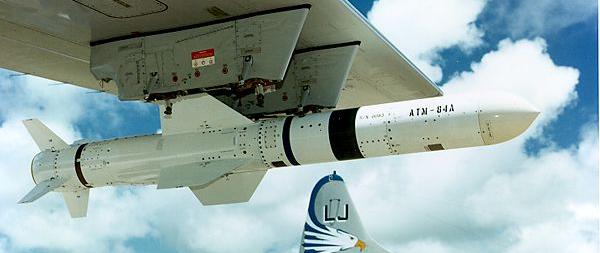|
|
|
AGM-84 Harpoon
Missile
|
|

|
The Harpoon is the only dedicated anti-ship missile in
service with U.S. armed forces. It has been developed into several
advanced versions, including the SLAM (Stand-off Land Attack
Missile) derivatives for high-precision attacks on land targets. The
Harpoon and SLAM will remain in service with the U.S.
Navy for the foreseeable future. Current U.S. platforms
for the AGM-84 are the Navy's F/A-18, P-3C and S-3B
and also a few B-52Hs of the USAF. The AGM-84E/H/K SLAM is
currently used by the F/A-18 only.
The name
Harpoon was assigned to the project (i.e. a harpoon to kill
"whales", a naval slang term for submarines). After the sinking of the
Isreali destroyer Eilat in 1967 by Soviet-built anti-ship
missiles, the U.S. Navy saw the need to develop a dedicated
anti-shipping missile, and therefore Harpoon's primary mission
became surface ship attack. The development project was formally begun
in 1968, and the missile designator ZAGM-84A was allocated in
1970 after the Navy had issued a formal RFP (Request For Proposals).
In June 1971, McDonnell-Douglas was awarded the prime contract for
Harpoon, and the first test missile flew in October 1972. By that
time it had already been decided to develop air-launched,
ship-launched and submarine-launched Harpoon variants,
designated AGM-84A, RGM-84A and UGM-84A,
respectively. Because the range requirement was increased to 90 km (50
nm), turbojet propulsion was selected by McDonnell-Douglas. Production
of the Harpoon began in 1975, and the first version to enter
service was the shipborne RGM-84A in 1977, followed by the AGM-84A on
P-3 aircraft in 1979. The UGM-84A became operational on attack
submarines in 1981. There are also unarmed training versions of the
AGM/RGM/UGM-84A, designated ATM-84A, RTM-84A and
UTM-84A.
The RGM-84A is usually fired from MK 140 (light weight) or MK 141
(shock-hardened) canister launchers, which hold four missiles, but
older MK 112 (ASROC) or MK 26 (Standard) launchers can also be used.
The RGM-84A has folding wings and fins which flip out immediately
after exit from the launcher. For target acquisition and tracking,
Harpoon-equipped surface ships use the AN/SWG-1 Harpoon Fire
Control System. For launch from submarines, the UGM-84A is enclosed in a capsule,
which glides to the surface after launch from the torpedo tube. When
the capsule breaks the surface, the front and end caps are ejected and
the missile fired. The digital MK 117 Fire Control System has full
support for Harpoon integrated.
More than 7000 Harpoon anti-ship missiles (including
production for foreign countries) and 1000 SLAM variants have
been built so far. Production of the anti-ship missiles continues for
non-US customers, while production for the U.S. Navy will continue
with the AGM-84K SLAM-ER ATA. |
Specificaitons::
| |
AGM-84D |
RGM/UGM-84D |
AGM-84E |
AGM-84F |
AGM-84H/K |
| Length |
3.85 m (12 ft 7.5 in) |
4.63 m (15 ft 2.2 in) |
4.50 m (14 ft 9 in) |
4.44 m (14 ft 6.9 in) |
4.37 m (14 ft 4 in) |
| Wingspan |
91.4 cm (36 in) |
2.43 m (96 in) |
| Diameter |
34.3 cm (13.5 in) |
| Weight |
540 kg (1200 lb) |
690 kg (1520 lb) |
627 kg (1385 lb) |
635 kg (1400 lb) |
725 kg (1600 lb) |
| Speed |
Mach 0.85 |
| Range |
220 km (120 nm) |
140 km (75 nm) |
93 km (50 nm) |
315 km (170 nm) |
280 km (150 nm) |
| Propulsion |
Sustainer: Teledyne/CAE J402-CA-400 turbojet; 3.0
kN (680 lb)
Booster (RGM/UGM-84 only): A/B44G-2 or -3 solid-fueled rocket; 53
kN (12000 lb) for 2.9 sec |
| Warhead |
221 kg (488 lb) WDU-18/B
penetrating
blast-fragmentation |
360 kg (800 lb) WDU-40/B penetrating BF |
|
|
